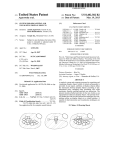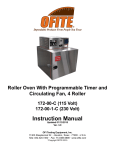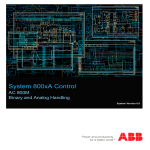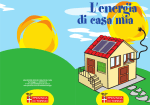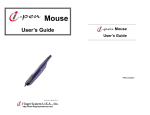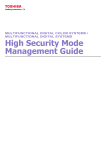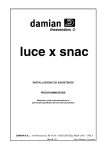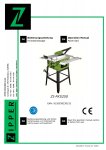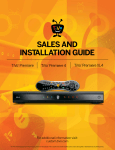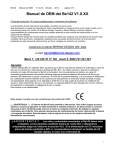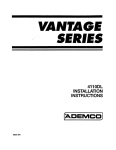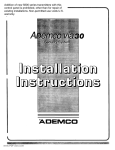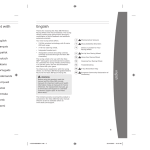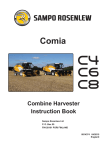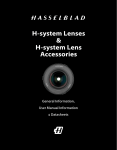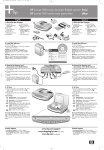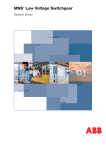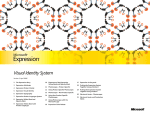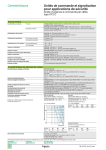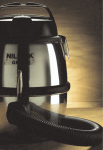Download Lore psum dolor sit amet, consectetur adipisicing e111, sec! :11
Transcript
USOO8896552B2
(12) Unlted States Patent
(10) Patent N0.:
Tan et a].
(54)
(75)
(45) Date of Patent:
GESTURES FOR SELECTING TEXT
.
-
.
- -
Inventors Welhua Tan,B6111ng(CN),Qlllang
Chen, Beijing (CN)
2008/0036743 A1*
2/2008 Westerman et a1. ........ .. 345/173
4/2009
Fyke et a1. .................. .. 345/173
2009/0125848 A1*
5/2009
Keohane et a1.
2009/0228792 A1,
2009/0228842 A1
9/2009 van OS etal‘ “““““““““ H mm,
9/2009 Westerman et a1.
2009/0271733 A1*
Notice:
10/2009
(22) Filed:
1129889
101390036
8/1996
3/2009
OTHER PUBLICATIONS
Jul. 11, 2011
(65)
Noma ......................... .. 715/784
FOREIGN PATENT DOCUMENTS
CN
CN
(21) Appl.No.: 13/179,893
715/863
(Continued)
Subject to any disclaimer, the term of this
patent is extended or adjusted under 35
U.S.C. 154(b) by 161 days.
Nov. 25, 2014
2009/0109182 A1*
(73) Assignee: Google Inc., Mountain View, CA (U S)
(*)
US 8,896,552 B2
Droid Forums. “‘Copy Paste It’ app cures your Android copy-and
paste woes.” [Retrieved on Dec. 1, 2010]. Retrieved from the Internet
Prior Publication Data
<URL: http://www.droidf0rums.net/forum/droid-news/65866-copy
US 2012/0306772 A1
Dec. 6, 2012
paste-app-cures-your-android-copy-paste-woes.html> (7 pages).
(Continued)
Related US. Application Data
(63) Continuation
of
application
No.
PCT/CN2011/075243, ?led on Jun. 3, 2011.
(74) Attorney, Agent, or Firm * Fish & Richardson PC.
(51)
Int. Cl.
G06F 3/041
G06F 3/01
G06F 3/033
G06F 3/0488
(52) US. Cl.
(2006.01)
(2006.01)
(2013.01)
(2013.01)
CPC .................................. .. G06F 3/0488 (2013.01)
USPC .......................... .. 345/173; 715/702; 715/863
(58)
Field of Classi?cation Search
USPC
......................... .. 345/1564184; 715/70(L866
See application ?le for complete search history.
(57)
ABSTRACT
In general, the subject matter described in this speci?cation
can be embodied in methods, systems, and program products
for selecting text using a touchscreen display of a computing
device. A computing device identi?es physical contact
between multiple ?ngers and the touchscreen display at a
starting location, wherein the identifying is in distinction to
identifying physical contact between a single ?nger and the
touchscreen display. The computing device determines that
the physical contact persists during movement of the physical
References Cited
contact from the starting location to an ending location. The
computing device determines that the physical contact was
U.S. PATENT DOCUMENTS
interrupted at the ending location. The computing device
identi?es that text displayed between the starting location and
(56)
5,825,352 A *
10/1998
6,891,551 B2*
5/2005
Keelyetal. .... ..
.. 715/762
5/2012
Lim ................... ..
.. 345/173
6/2006 Westerman et a1. .
345/173
8,169,414 B2*
2006/0125803 A1*
2007/0287494 A1*
392
Primary Examiner * Amr Awad
Assistant Examiner * Roberto Flores
Bisset et a1.
................ .. 345/173
12/2007 You et a1. ................. .. 455/5501
the ending location is text that has been selected by a user of
the computing device.
12 Claims, 9 Drawing Sheets
304
Lore psum dolor sit amet, consectetur adipisicing e111, sec! :11: eiusmacl tempo;
incidi n1 iabore et dsisre magma aliqua. Ut enim ad minim venéam, quis nostrud
exercit i n uliamco iaboris nisi ut aliquip ex ea commodo consequat. Duis aute irure
US 8,896,552 B2
Page 2
References Cited
MitchiBlackBerry Tips. “BlackBerry Storm: Highlight, Cut/Copy
U.S. PATENT DOCUMENTS
and Paste Text.” Nov. 23, 2008 [Retrieved on Dec. 1, 2010]. Retrieved
from the Internet <URL: http://www.technipages.com/blackberry
storm-highlight-cut-copy-and-paste-text.htrnl multitouch text selec
(56)
2010/0085314
2010/0088653
2010/0110017
2010/0171713
2010/0235726
2010/0235793
A1*
A1*
A1*
A1*
A1*
A1*
2010/0245261 A1*
4/2010
Kwok
......................... .. 345/173
4/2010 Yach et a1.
. 715/863
5/2010
Lee ............................. .. 345/173
7/2010
Kwoketal.
................ .. 345/173
9/2010 Ording et al.
9/2010 Ording et al.
9/2010 Karlsson
2010/0289757 A1*
11/2010
2010/0293460 A1
11/2010 Budelli
2010/0313126
2011/0234503
2011/0260962
2011/0310026
A1*
A1*
A1*
A1*
12/2010
9/2011
10/2011
12/2011
2012/0019452 A1*
1/2012
. 715/234
. 715/863
. 345/173
Budelli ....................... .. 345/173
Jung et a1. ................... ..
Fitzmaurice et a1. .
.
Benko et al. ................ ..
Davis et a1. ................. ..
715/702
345/173
345/156
345/173
. 345/173
2012/0127086 A1*
5/2012
Westerman .
L1' ................ ..
2012/0139844 A1*
2012/0144298 A1*
6/2012 Ramstein et al.
6/2012 Karlsson
. 345/173
. 715/702
2012/0311507 A1*
12/2012
. 345/173
Murrett et al. .............. .. 715/863
OTHER PUBLICATIONS
Everything iCafe. “Did anyone else notice the two ?nger trick with
copy and paste?” [Retrieved on Jul. 11, 2011]. Retrieved from the
Internet <URL: http://www.everythingicafe.com/forum/threads/did
tion with BlackBerry Storm> (3 pages).
Ritescript. “ritePen 4.0 User Manual.” Mountain View, CA; 2009
[Retrieved on Dec. 1, 2010]. Retrieved from the Internet <URL:
http ://www. ritescript.com/ Manual s/ritePenManual.
aspx#multitouch> (43 pages).
Roth, Volker and Thea Turner. “Bezel Swipe: Con?ict-Free Scrolling
and Multiple Selection on Mobile Touch Screen Devices.” Palo Alto,
CA; 2009. (4 pages).
The Windows Club. “Touch Gestures in Windows 7.” Oct. 18, 2009
[Retrieved on Dec. 1, 2010]. Retrieved from the Internet <URL:
http://www.thewindowsclub.com/touch-gestures-in-windows-7
multitouch text selection with Windows 7> (6pages).
Trautschold, Martin and Gary Mazo. “iPhone 4 Made Simple.” pp.
93-94. NewYork, NY; 2010. (2 pages).
XDADevelopers. “[APP] Copy/Past BetaiSelecting Text Using
OCR (Dec. 11, 2010).” [Retrieved on Mar. 9, 2011]. Retrieved from
the Internet <URL: http://forum.xda-developers.com/showthread.
php?t:846089> (8 pages).
Authorized Of?cerY. Tang. International Search Report and Written
Opinion in International Application No. PCT/CN2011/075243,
mailed Mar. 15, 2012, 12 pages.
anyone-e1se-notice-the-two-?nger-trick-with-copy-and-paste.
44414/> (5 pages).
* cited by examiner
US. Patent
Nov. 25, 2014
Sheet 1 0f9
US 8,896,552 B2
302
Lorem ipsun doior sit amet, consectetur adipisicing eiii, sad (is eiusmod tempo!
incididunt ut ia‘nore et dam magma aiiqua. Ut enim ad minim veniam, qués nostrud
exemitation uiiamc laboris nisi ut aiiauip ex ea cammado consecxuat. Duis aute imre
($010? in venrehen "l: in vowntaie veht ease ciilum do¥0re eu fuaiat nuéia pariatur.
Excemeur sint N ’ cat cupidatat nun aroident, aunt in culaa qui o?écia deserurlt moliii
anim id est labf “é. Lorem insum doler sit amet. censectetur adipisicim e?ii, sed dc
eiusmsd temps. cididunt ui ?abore ei dolore magna aiiqua. Lorem ipsum dole! sit
amet, consectetuy adiaisicinu eiit, sed dc eiusmod temor incidi a“,
magma aéiqua. Duis ante ime dainr in reprehenderit in voluptate >
Ut enim ad minim veniam, qués nostwd exeycitaiion uiiamcur
* bore e‘: doiore
.
aliquip ex ea commado consequat. Duis aute irure 60k)? in reps'ehe e?i in voiuptate
veiit esse ciilum doiore eu fugiat nulia pariatur. Excepteur sint occaecat cupidata‘t non
proldent, aunt m oulpa qw officia deserunt mslirt amm id est ?aborum.
FiG. i
202
Lcrem ipsum doior sit amet, consectetur adipisi ' gem, sed do eiusmod tempo?
éncididunt ut iabcre et demre magma aiiqua. Ut enim ad ‘inim veniam, quis nostrud
exercitation uiiamco laboris nisi ut aiiquip ex ea cammod
dais; in {enrehenderét in vuiusta?e velét esse ci?um
Excepteur sint occaecat cupidatat non proi
.D i
u 'jrure
u mqiat nuiia aariatur
n culga qui officia deserunt meliit
anim id est laberum. Lorem insum deier sit}
* adipisicing am, sad dc:
eiusmod tempo? Enaididunt ut tabore et do!
ipsum dam sit
amet, consecteiur adipisicing eiit, sec! do ems
* iabore ei doiore
magma aiiqua. Quis ante iwa'e doior in reprehenderit in voluptate veiit ess . 204
Ht enim ad minim veniam, quis nastrud exemitaiion uliamco iaboris nisi ut
aliquip ex ea commodo consequat. Duis aute irure c3030; in {eprehenderéi in voiuptaie
velit esse ci§lum dolqe eu fugiat nul?a pariatur, Excepteur sint occaecat cupédatai non
FEG. 2
US. Patent
302
Nov. 25, 2014
Sheet 2 0f9
US 8,896,552 B2
304
Lars psum dolor sit amet, consectetur adipisicing eiii, sec! cit; eiusmsd tempo;
incidi nt L iabm'e et dame magma aliqua. Ut enim ad minim veniam, quis nostrud
exercit i n uliamco iaberis nisi ut aiiquip ex ea cammade cansequat. Duis aute irure
'
rehenderit in vsiuatate velét esse ciiium deiare eu fuqiat nuiia a3
.
" toccaecat cupidaiat rm proicient, aunt in cuipa qui of?cia de
FIG. 3
404
402
486
*- T$.W..iP.$<i{m£19.l....§i?..%!1?§ii .qqq22qt?bi'aqipiaiqimm 39d d3 eiusmad temp??‘
incididu :Ui_iabme§lOE§,_FE¥§Q?1%§?1QQ%;QI..§¥¥P§Q@M¥FEVQHiam, Wis nostrud
exercita?c?Wi
am in {sprehenderi’ii
F: nisi ut aiiquip ex ea ccmmsds cansequat. Duis ante irure
' mats velit esse ci?um dclsre eu fugiat nulia §ariatur.
Excepteur sint occaecat upidaiat nan proiéent, sunt in culpa qui of?cia deserunt moiiit
anim id est Iaborum. Lez'em ipsum doior sit amet, consectetur adipisicing eiii, sed do
FEG. 4
US. Patent
Nov. 25, 2014
502
Sheet 3 0f9
504
US 8,896,552 B2
506
eiusmod tempor incididuni utl die idol re magma aiiqua. Lorem ipsum dOiOi' sit
amet, conseciatur adipisicirig lit, d do idsmod tampdr incididuni ut iabdre at doiOie
magma aiiqua.
lUi enim ad minim veniiam, buisiiostrud exercitaiion uliamco iabdris nisi uil
aiiduid ex ea commddo co m 0
is auta irure doim in repiahendaiii in vdiudtaie
veiii
proiderit,
ease aunt
ciilurnin doiore
cuipa and
euf T:
‘ ciiium ddidre a
, ant, - FiisiAciidn
doidr
Excepieur
in raprai'iaddarit
sini ' in vi
uiai nuiia ariaiua
J i officia deseruni mam
?at ciiinidaiat nod/pinidenii
~' at ddidie magma aiiqua. Ui enim ad minim
iamco laboris nisi iii aiiquip ex ea commodo
= i.»
eu fugiat nuiia pariatur. Ex .
_ ,‘ anderii in voiupiae veliiasse ciiium doiore
, Lii‘ sini occaecat cupidatat non grdiderii, sum in cuipa
did d?idia deseruni moiiii an: id est iaiiordm. Ui enim ad minim veniam, quis nostrud
HS. 5
662
Lorem ipsum ddior sit amei, consecteidr adipisicing eiii, sed do eiusmdd tempoi
incidid *nt ui iabdra ei dolore magna aiiqua. Ui enim ad minim veniam, quis nosiiud
' .
a uiiamcn iaboris nisi iii aiiduip ex ea commddo consaauat. Duis auta irure
ddioi inliepiehandeiii id voiuptaie vaiii ass-a siiium doiOi'a 8U fugiat duiia pariaiuri
Exceptaur sin! occaacai dupidatai non didideni, suni iri duipa qui efficia deserurii moiliii
anim id est iaborum. Ldi'em issum dolor sit amet, conseciemi adipisicind eiii, sad dol
eiusmod tempoi incididuni iii iabore at dolore magna aiiqua. Larem ipsum doior sii
amei, oonsecteiui' adiaisicind eiii, sed do eiusmod iammi incididdnl ui iabore ei doiore
magna aliqua. Duis aute irure ddidi' iri reprehendeiii in voiuptaie @esse. 694
Ut enim ad minim vaniam, quis nosiidd axerciiaiidn diiamcd iaboris nisi ut
aiiquip ex ea commodo consequai. Duis auie iiure dolor in raprehenderit in volupiate
veiit esse cilium doiore eu iugiat ndiia pariaiu'i. Excepiaur sirii dccaecai cupidaiat don
pioident, aunt in cuipa qui officia deseiunt moiiii anim id est iabordm.
FiG, 6
US. Patent
NOV. 25, 2014
Ea<E@5ng
5%2mmg 595
E3ngéag $wasawg.a8o,m23
US 8,896,552 B2
Sheet 4 0f 9
N:
1/m
86:
6525%. \>
QNNW
ED,
NMK
wan“,me
\
if
_ _E92§,>mw_ _
__
.6Ni<E52grimmm
3
5
6
,
|
l
E
I
i
S
E
U
W11%
E
Mm
$55Eng
Hmwao>gH.wcL3Qfma,gmwfagmz
élggéi. é
@
NW
X
Q
HEE E
US. Patent
Nov. 25, 2014
Sheet 5 0f9
US 8,896,552 B2
5 862
identify physicat contact with teuchsereen at a starting tecatien
S 5'04
[
Determine quantity at adjacent ?ngers
J
f.
Determine an intermediate iccaticn
S 808
[
Dispiay indicatien of intermediate iocatien
J
x
1
¢
5‘ 8.20
r
\
identify text as eeiected
5 812
P”
‘\
Determine whether physieai contact is interrupted hetere intermediate iocatien
\
j
5‘ 814
.
.
.
.
.
Determine whether physzcai contact passes intermediate tecation and returns
in between the starting iocation and the intermediate iocatie-n
\
1
S 816
,
_
_
_
‘i
Determine whether physmai contact With teuchscreen moves a determined
\ctisterice frem a direct mute between starting iocation and intermediate tecatien.)
5“ 816’
[ Select mtiitipie tines if movement strays from route after intermediate tocatien J
5 820
[
Seiect unit at text based on quantity cf adjacent ?ngers
\
]
J
(Fits.
______ as i
\
FiG. 8A
1’
US. Patent
Nov. 25, 2014
Sheet 6 0f9
_ .......
US 8,896,552 B2
....... M
Diepiay indication that text has been eeiected during movement
S 825
824
( Do not dispiay indication before movement passes intermediate iocaticn J
Determine addition or removai of finger during movement
[
Seiect shorter unit of text
5 828
1
S 830
[
Seieet ionger unit of text
J
Kc
J
1
f
5,3,
\
Determine that physicet contact has moved from starting location to an ending iocation
5 834
[ Physicai contact with touchscreen is not interrupted during movement 1
to
J
i
5 836
r
"\
Determine that physicai contact was interrupted at the ending iooation
J
K.
i
5 838
identify user interaction with dispiayed indication of seiectect text
5 840
[
Perform action based on form of user interaction
FiG. EB
1
US. Patent
Nov. 25, 2014
Sheet 7 0f9
US 8,896,552 B2
Physical; Contact Daterminer
5‘ 904
Graphicai Dismay Generator
5 905
Text S-aiectinn Determine-r
; 908
Action Determiner and Performer
HQ. 9
US. Patent
NOV. 25, 2014
@
W
m
c
3
w
m
i
8
5
3
%
n
>
g
“WE
mwo*.
Sheet 8 0f 9
US 8,896,552 B2
Q@uEamw? 53%a m
mum?
3.
US. Patent
M
mm:: mam
Wgm
QH H
NOV. 25, 2014
Sheet 9 0f 9
US 8,896,552 B2
US 8,896,552 B2
1
2
GESTURES FOR SELECTING TEXT
the ending location; and identifying, by the computing
device, text displayed between the starting location and the
ending location as being text that has been selected by a user
CROSS-REFERENCE TO RELATED
APPLICATION
of the computing device.
Implementation 2 is directed to the method of implemen
tation l. The method further comprises determining, by the
This application claims bene?t under 35 U.S.C. §l20 of
computing device, an intermediate location that is offset a
International Application No. PCT/CN2011/075243 having
predetermined distance from the starting location.
an International Filing Date of Jun. 3, 2011.
Implementation 3 is directed to the method of implemen
tation 2. The method further comprises displaying, by the
computing device and during the movement of the physical
TECHNICAL FIELD
contact from the starting location to the ending location after
the physical contact has reached or passed the intermediate
This document generally relates to user interfaces.
BACKGROUND
location, an indication that text between a location of the
Computing devices can display text and allow users to
select portions of the displayed text. For example, a user may
physical contact and the starting location has been selected.
Before the physical contact reached or passed the intermedi
ate location, the computing device did not display the indica
tion that text between the location of the physical contact and
the starting location had been selected.
use a mouse or a keyboard to highlight a portion of text that is
displayed as part of a word processing document or as part of
a web page. Once the text has been highlighted, the user may
20
keyboard shortcut or selecting a graphical menu item with a
contact has reached or passed the intermediate location
causes the computing device to identify that text has been
mouse. Example actions include copying and pasting the text,
and changing a font style of the selected text.
Mobile devices can provide different user experience from
desktop devices. For example, some mobile devices have
25
selected; and (ii) interruption of the physical contact before
the physical contact has reached or passed the intermediate
location causes text selection to be cancelled.
screens that are smaller than desktop display screens, some
mobile devices do not have a mouse, and some mobile devices
provide for user input using a touchscreen. A touchscreen can
allow a user to provide user input to a mobile device using
Implementation 4 is directed to the method of any one of
implementations 2-3. The computing device is con?gured so
that: (i) interruption of the physical contact after the physical
perform an action with the text, for example, by providing a
Implementation 5 is directed to the method of implemen
tation 4. The method further comprises determining that the
gestures, for example, hand, ?nger, or stylus movements
movement of the physical contact reaches or passes the inter
mediate location, so that the physical contact is not located
across the surface of the device’s touchscreen. Such gestures
between the starting location and the intermediate location,
30
and that the movement of the physical contact thereafter
can be used to select text.
returns to the ending location, the ending location being
SUMMARY
35
between the starting location and the intermediate location.
Implementation 6 is directed to the method of any one of
A user may select text that is displayed on a touchscreen
implementations 4-5. The computing device is con?gured to
display device by physically contacting one or more ?ngers
with the surface of the touchscreen to perform particular
not identify that text has been selected by a user of the com
gestures. Once the user has performed a gesture, the mobile
device may identify a portion of text as selected and may
display a visual indication of the portion that has been
puting device if the computing device determines that the
40
gential distance from a shortest route between the starting
location and the intermediate location before the physical
selected. The user may further contact the touchscreen to
perform an action on the text. For example, the user may copy
the text by tapping a region of the touchscreen that displays
contact reaches or passes the intermediate location.
45
the selected text. In a second example, the user may tap or
long press the region of the touchscreen that displays the
selected text in order to cause the mobile device to display a
menu of actions that can be performed on the text (e.g., text
copying, text deletion, text font size change, text font type
change, text font emphasis change, and text font color
50
change).
55
text of at least portions of multiple displayed lines of text on
the touchscreen display has been selected by the user of the
device if the physical contact moves the predetermined tan
gential distance after the physical contact passes the interme
diate location.
Implementation 8 is directed to the method of any one of
interface element that was not displayed at the intermediate
location before identifying the physical contact at the starting
location.
Implementation 9 is directed to the method of any one of
computing device. The method comprises: identifying, by a
computing device, physical contact between multiple ?ngers
Implementation 7 is directed to the method of implemen
tation 6. The computing device is con?gured to identify that
implementations 2-7. The method further comprises display
ing, by the touchscreen display and at the intermediate loca
tion during the movement of the physical contact, a graphical
As an alternative to the attached claims and the implemen
tations described in the below description, the present inven
tion could also be described by one of the following imple
mentations:
Implementation 1 is directed to a computer-implemented
method for selecting text using a touchscreen display of a
movement of the physical contact moves a determined tan
implementations 1-8. The method further comprises deter
60
mining that the multiple ?ngers remained adjacent during the
and the touchscreen display at a starting location, wherein the
identifying is in distinction to identifying physical contact
between a single ?nger and the touchscreen display; deter
movement of the physical contact from the starting location to
mining, by the computing device, that the physical contact
implementations 1-9. The method further comprises indicat
ing, by the computing device and on the touchscreen display
during the movement of the physical contact, that text
persists during movement of the physical contact from the
starting location to an ending location; determining, by the
computing device, that the physical contact was interrupted at
the ending location.
Implementation 10 is directed to the method of any one of
65
between a location of the physical contact and the starting
US 8,896,552 B2
3
4
location is selected using a ?rst text selection mode based on
the physical contact including a ?rst quantity of one or more
that can be performed using the selected text. The second
action is another action from the group.
Implementation 16 is directed to a computer-implemented
method for selecting text using a touchscreen display of a
?ngers; determining, by the computing device and during the
movement of the physical contact, that the ?rst quantity of
computing device. The method comprises identifying, by a
computing device, physical contact at a starting location with
a touchscreen display; determining, by the computing device,
one or more ?ngers has changed to a second quantity of one
or more ?ngers; and indicating, by the computing device and
on the touchscreen display and during the movement of the
physical contact in response to determining that the ?rst
an intermediate location that is offset a predetermined dis
tance from the starting location, wherein the computing
device is con?gured so that: (i) interruption of the physical
quantity of one or more ?ngers has changed to a second
quantity of one or more ?ngers, that text between the location
of the physical contact and the starting location is selected
contact with the touchscreen display after the physical con
using a second text selection mode.
tact has reached or passed the intermediate location causes
Implementation 1 l is directed to the method of implemen
the computing device to identify that text has been selected,
and (ii) interruption of the physical contact with the touch
tation 10. The ?rst text selection mode is a text selection mode
selected from a group consisting of: (i) a text selection mode
that causes text between the location of the physical contact
and the starting location to be selected as whole words so that
partial words are not indicated as selected during the move
ment, and (ii) a text selection mode that causes text between
the location of the physical contact and the starting location to
screen display before the physical contact has reached or
passed the intermediate location causes the computing device
to cancel text selection; determining, by the computing
device, that the physical contact with the touchscreen display
has reached or passed the intermediate location without inter
20
be selected as individual characters so that partial words are
tact with the touchscreen display was interrupted at the end
ing location for a ?rst instance greater than a threshold time
indicated as selected during the movement; and the second
text selection mode is the other text selection mode from the
group.
Implementation 12 is directed to the method of implemen
tation 10. The ?rst text selection mode is a text selection mode
selected from a group consisting of: (i) a text selection mode
that causes text between the location of the physical contact
and the starting location to be selected as whole words so that
partial sentences are indicated as selected during the move
ment, and (ii) a text selection mode that causes text between
ruption of the physical contact with the touchscreen display;
determining, by the computing device, that the physical con
25
during a movement of the physical contact; identifying, by
the computing device, text displayed between the starting
location and the ending location as being text that has been
selected by a user of the computing device; and displaying, by
30
the computing device, an indication that the text that is
between the starting location and the ending location is text
that has been selected by a user of the computing device.
Implementation 17 is directed to the method of implemen
tation 16. The method further comprises indicating, by the
the location of the physical contact and the starting location to
be selected as whole sentences so that partial sentences are
computing device and on the touchscreen display during the
not indicated as selected during the movement; and the sec
ond text selection mode is the other text selection mode from
the group.
Implementation 13 is directed to the method of any one of
implementations l - l 2. Identifying text displayed between the
movement of the physical contact, that text between a loca
starting location and the ending location as being text that has
been selected includes identifying: (i) if the physical contact
includes a ?rst quantity of ?ngers, a ?rst partial word that
35
selected using a ?rst text selection mode based on the physical
contact including a ?rst quantity of one or more ?ngers;
determining, by the computing device and during the move
ment of the physical contact, that the ?rst quantity of one or
40
contact in response to determining that the ?rst quantity of
one or more ?ngers has changed to a second quantity of one
45
corresponds to an intermediate location in the ?rst whole
50
implementations 1-13. The method further comprises dis
playing, by the computing device and after determining that
the physical contact was interrupted, an indication that text
between the starting location and the ending location has been
selected; and wherein the computing device is con?gured so
that, subsequent to determining that the physical contact was
55
60
at a location of the displayed indication using multiple ?ngers
tion of the physical contact and the starting location to be
selected as whole sentences so that partial sentences and
partial words are not indicated as selected during the move
ment; and the second text selection mode is another text
causes the computing device to perform a second action.
Implementation 15 is directed to the method of implemen
tation 14. The ?rst action is one action from a group consist
selected text, and (v) displaying a menu of multiple actions
the location of the physical contact and the starting location to
indicated as selected during the movement and so that partial
sentences are indicated as selected during the movement, and
(iii) a text selection mode that causes text between the loca
played indication using a single ?nger causes the computing
ing of: (i) copying the selected text, (ii) deleting the selected
text, (iii) cutting the selected text, (iv) pasting over the
tation 17. The ?rst text selection mode is a text selection mode
selected from a group consisting of: (i) a text selection mode
that causes text between the location of the physical contact
and the starting location to be selected as individual charac
ters so that partial words are indicated as selected during the
movement, (ii) a text selection mode that causes text between
be selected as whole words so that partial words are not
interrupted: (i) user physical contact at a location of the dis
device to perform a ?rst action; and (ii) user physical contact
or more ?ngers, that text between the location of the physical
contact and the starting location is selected using a second
text selection mode.
Implementation 18 is directed to the method of implemen
word, and a second whole word that corresponds to the ending
location as selected, even though the ending location corre
sponds to an intermediate location in the second whole word.
Implementation 14 is directed to the method of any one of
more ?ngers has changed to a second quantity of one or more
?ngers; and indicating, by the computing device and on the
touchscreen display and during the movement of the physical
corresponds to the starting location as selected and a second
partial word that corresponds to the ending location as
selected; and (ii) if the physical contact includes a second
quantity of ?ngers, a ?rst whole word that corresponds to the
starting location as selected, even though the starting location
tion of the physical contact and the starting location is
65
selection mode from the group.
Implementation 19 is directed to the method of any one of
implementations 16-18. The method further comprises dis
playing, by the touchscreen display and at the intermediate
US 8,896,552 B2
6
5
Like reference symbols in the various drawings indicate
location during the movement of the physical contact, a
graphical interface element that was not displayed at the
intermediate location before identifying the physical contact
at the starting location.
like elements.
DETAILED DESCRIPTION
Other implementations include corresponding computer
readable storage devices storing instructions that, when
This document generally describes techniques for select
ing text and recognizing that displayed text has been selected.
executed by one or more processing devices, perform opera
tions according to the above-described methods. Other imple
mentations include systems and apparatus that include the
described computer-readable storage devices and that are
In some techniques, a user may select text that is displayed on
a touchscreen of a computing device by swiping one or more
of the user’s ?ngers across the text that the user wishes to
select. The text that is selected may include text that is
con?gured to execute the operations using one or more pro
included between a beginning location of the swipe gesture
and an ending location of the swipe gesture. For text to be
cessing devices.
Implementation 20 is directed to a computing device. The
computing device comprises one or more programmable pro
cessors; and a computer-readable storage device coupled to
selected, the user may need to contact the touchscreen with
multiple ?ngers. For example, text may be selected if the user
swipes two adjacent ?ngers simultaneously across the screen,
the one or more programmable processors and having
but not if the user swipes one ?nger across the screen, swipes
two ?ngers that are not adjacent, or does not swipe two ?ngers
instructions stored therein, which when executed by the one
or more programmable processors, causes the one or more
programmable processors to perform operations including:
20
multiple ?ngers and a touchscreen display; determining that
the physical contact persists without interruption during
screen may display a visual indication of a location of the
movement of the physical contact from the starting location to
the ending location; determining that the physical contact
simultaneously.
In some examples, text is only selected if the user swipes
for a predetermined distance after beginning contact with the
touchscreen. After the user begins a swipe gesture, the touch
identifying physical contact at a starting location between
25
predetermined distance. Terminating the swipe gesture
with the touchscreen display was interrupted at the ending
before the user contacts the visual indication may cause text
location; and identifying text displayed between the starting
to not be selected, while terminating the swipe after the user
location and the ending location as being text that has been
selected by a user of the computing device.
Particular implementations can, in certain instances, real
the text traversed by the swipe gesture.
contacts orpasses the visual indication may cause selection of
30
ize one or more of the following advantages. A user may be
able to quickly select a portion of text by touching a touch
screen display. Also, gesture constraints may minimize unin
tentional selections of text by a user. Visual indications of
such constraints may also allow a user to understand a gesture
that the user must perform to select text. In certain examples,
the user can change a level of granularity at which text is
user would like to select. In some examples, the user may
35
select text that is displayed across multiple lines of text. To
select such text on multiple lines the user may horizontally
40
tion of the swipe gesture to a direction crossing lines of text to
select a contiguous portion of text that spans multiple lines.
A mode of text selection may depend on how many ?ngers
the user simultaneously places in contact with the touch
swipe the predetermined distance before changing the direc
selected (e.g., selection by characters, words, sentences, or
paragraphs).
For the user to select a portion of text that is shorter than the
predetermined distance, the user may swipe to the visual
indication and return to an end of the portion of text that the
The details of one or more implementations are set forth in
screen during a swipe gesture. For example, swiping with two
the accompanying drawings and the description below. Other
features, objects, and advantages will be apparent from the
description and drawings, and from the claims.
?ngers may cause selection of text on a word-by-word basis,
while swiping with three ?ngers may cause selection of text
on a sentence-by-sentence basis. A user may be able to
45
change a mode of text selection during a swipe gesture, for
DESCRIPTION OF DRAWINGS
example, by adding or removing ?ngers to the display. A
FIG. 1 illustrates a technique for selecting text with a long
press by a ?rst ?nger and a touch by a second ?nger.
FIG. 2 illustrates a technique for selecting text with a press
with each other may be required in order to invoke the corre
determination that multiple ?ngers are in adjacent contact
sponding text selection mode.
50
by two separated ?ngers.
played, for example, by highlighting the selected text or dis
FIG. 3 illustrates a technique for selecting text with a
multi-touch swipe gesture.
FIG. 4 illustrates a technique for selecting text with a
single-touch swipe gesture.
55
FIG. 5 illustrates a technique for selecting text with a
60
FIG. 10 is a conceptual diagram of a system
FIG. 11 is a block diagram of computing devices.
the font size of selected text, changing the font type of
selected text, changing a shading behind the selected text, and
adding or removing emphasis to the selected text.
The action that is performed using the selected text may be
based on user interaction with the selected text (e.g., user
selecting text.
FIG. 9 is a conceptual diagram of a system for selecting
text.
playing the selected text in a pop-up box. After selecting text,
the user may perform an action using the selected text.
Example actions include copying selected text so that it can
be pasted, cutting selected text so that it can be pasted, delet
ing selected text, changing the color of selected text, changing
compound multi-touch swipe gesture.
FIG. 6 illustrates a technique for adjusting a selected text
range.
FIG. 7 illustrates an example display of selected text.
FIGS. 8A-8B show a ?owchart of an example process for
Text may be selected after a user removes his ?ngers from
the touchscreen. An indication of the selected text is dis
65
contact with a region of the touchscreen that displays the
selected text). For example, a single-?nger tap over the dis
played text may perform a ?rst action, while a double-?nger
tap (tapping simultaneously, or approximately simulta
neously, with two ?ngers touching each other) may perform a
US 8,896,552 B2
7
8
second action. A swipe across the displayed text may perform
a third action, while a long press with a single ?nger may
perform a fourth action.
Various additional or supplementary gestures for selecting
some examples, the second contact must occur both after a
predetermined amount of time following the ?rst contact and
before another predetermined amount of time following the
?rst contact. If the ?rst contact with the screen persists for too
long, a cursor may appear for display at the location of the ?rst
text are described in this document. For example, this docu
ment hereinafter describes multiple different mechanisms for
contact. The cursor may not enable text selection or may
selecting text that is displayed by a computing device, and
enable text selection using a different gesture.
Text may be displayed as selected (e.g., the text may be
highlighted or shown in a different color than non-selected
text) after the second contact with the display. Once the text is
displayed as selected, the user may change a region of
selected text by moving one or both of the contacts with the
screen. As an example, the user may spread his ?ngers farther
interacting with text that has been selected by a user of the
computing device.
Text Selected Mode
A computing device may be programmed to enter a text
selected mode after the device determines that a user per
formed a text selection gesture. Once the device is in the text
selected mode, user interaction with the device may be dif
ferent than when the device is not in the text selected mode.
For example, while the device is not in the text selected mode,
a user may be able to drag the display with a one-?nger swipe
apart to select more text or closer together to select less text.
In some examples, the long press may designate a start to the
selected portion of text or an end to the selected portion of
text. In some examples, if the user does not complete the text
across the touchscreen and zoom out or in by pinching or
spreading two ?ngers that contact the touchscreen. Once the
device is in the text selected mode, the computing device may
selection gesture (e.g., the user does not perform the “touch”)
20
disable one or more of the dragging and zooming user input
operations. In other words, once a user has selected text, the
user may not be able to drag or zoom the display until the user
provides user input to exit the text selected mode, for
example, by tapping a portion of the touchscreen that does not
Press by Two Separated Fingers
25
show selected text.
As described in more detail below, once a user has selected
text and the device is in text selected mode, the device may
recognize user input gestures or operations that the device
does not recognize when not in the text selected mode. For
example, a user may be able to copy text by tapping a single
?nger on text that has been selected. When the device is not in
30
As illustrated in FIG. 2, an example text selection gesture
includes two ?ngers 202 and 204 contacting different loca
tions in a body of text at substantially the same time (e.g.,
within a predetermined time of each other). As described
above with respect to the “long press by a ?rst ?nger and a
touch by a second ?nger” gesture, the user may adjust one or
more of his ?ngers to change a region of the selected text. The
device may cancel a text selection operation, after a two
?nger text selection gesture has been invoked, if the device
determines that the user has moved his ?ngers together until
the ?ngers touch and then removed his ?ngers from the dis
play at substantially the same time.
the text selected mode, however, tapping text that is shown by
the display may not copy text.
The following portion of the document describes various
within a predetermined amount of time, the text selection
gesture is not completed and text is not selected.
35
Two Adjacent Finger Swipe Gesture
user input mechanisms for selecting text.
Long Press by a First Finger and a Touch by a Second
As illustrated in FIG. 3, an example text selection gesture
includes two ?ngers 302 and 304 that are adjacent swiping
Finger
across a line of text to select the text. As discussed in more
As illustrated in FIG. 1, an example text selection gesture
includes a ?rst ?nger 102 performing a long press on the
display and a second ?nger 104 thereafter touching a different
detail later, ?ngers may be determined by the computing
40
portion of the display. The portion of text that is between the
two ?ngers is selected by the computing device. The portion
of text may include text from multiple horizontal lines of text.
In such examples, each of the lines that are between the
In some examples, the computing device requires that the
?ngers 302 and 304 contact the display within a predeter
45
mined time of each other in order to invoke the gesture.
As described in greater detail below, the user may swipe his
?ngers a predetermined distance before the text selection
gesture is activated. Further, the user may follow a horizontal
50
move his ?ngers vertically to select additional lines of text.
The text may be selected upon the user releasing his ?ngers
?ngers may be selected in their entirety, and the lines that
were contacted by the user may be partially selected. The
partial selection may include text to the right of the ?nger that
contacted the screen at the highest position on the screen and
text to the left of the ?nger that contacted the screen at the
lowest position (when the device is oriented to read text from
left to right). In other words, the selected text may include all
text that a user would read starting at the ?nger that contacted
the screen at the highest position until the user reached the
text that the user contacted with the ?nger in the lowest
device to be adjacent, for example, if a center of a region of
contact for a ?rst ?nger 302 is within a predetermined dis
tance of a center of a region of contact for a second ?nger 304.
line of text for a predetermined distance before the user can
from the display. In some examples, both ?ngers may release
from contact with the display (e.g., interrupt their contact
with the display) within a predetermined time of each other in
55
order to select text.
position.
One Finger Swipe Gesture
In this example, the “hold” may be determined as a ?rst
physical contact with the screen in a position that is deter
As illustrated in FIG. 4, an example text selection gesture
includes one ?nger 402 swiping across a line of text to select
mined to be substantially ?xed (e.g., moving less than a
predetermined distance) for a predetermined amount time.
The determination may include the contact being determined
to be an only physical contact with the display. The touch may
the text. The portion of text that is selected may be the portion
between the location of the start of the contact 404 and the
location of the end of the contact. As described below in
greater detail, a user may swipe for a predetermined distance
60
before the text selection gesture is activated. In some
be a second contact with the screen that occurs after the
determined amount of time and while the ?rst contact remains
substantially ?xed. To invoke the text selected mode, both
contacts may remain in substantially ?xed positions for a
predetermined amount of time after the second contact. In
65
examples, this distance is illustrated on the touchscreen by the
computing device. For example, in FIG. 4, the user contacted
the display of text at the starting location 404 and thereafter
the computing device displayed the box 406 on the display.
US 8,896,552 B2
10
The device may not enter the text selected mode if the user
their original positions bounding the word “8PM” to the
does not swipe through the end of the box within a determined
amount of time. As described above with reference to the
swiped the predetermined distance through the right-most
locations that are shown in display 724.
Actions in Text Selected Mode
As also described below, once the computing device is in
the text selected mode, in response to the device determining
end of the box 406, the user may move his ?nger up or down
in a vertical direction to select portions of additional lines of
provide user input to perform various actions. For example,
“swipe by two adjacent ?ngers” gesture, once the user has
that the user performed a text selection gesture, the user may
text. The one ?nger swipe gesture may not be recognized if
the device determines that another object is contacting the
the user may contact an area of the display that does not
display selected text in order to exit the text selected mode. A
user may contact the selected text with a single ?nger to
touchscreen display at the same time as the ?nger 402.
In some examples, a one-?nger swipe gesture is available
only for portions of a display that cannot pan (e.g., an address
launch a default action (e.g., copying the text). A user may
contact the selected text with two adjacent ?ngers to launch a
bar of a web browser where the content display area of the
secondary action (e.g., performing an internet search with the
web browser that displays web page content may pan). As
selected text). A user may contact the selected text with three
described in greater detail below, in some examples, a user
may not begin a text selection gesture with a one-?nger swipe
adjacent ?ngers to launch a tertiary action (e.g., generating a
gesture but may release one or more ?ngers to ?nish with a
pop-up menu of actions that can be performed using the text).
one-?nger swipe gesture. Such a change in the gesture can
change a type of text selection (e.g., whether the device
selects text by character or whole word).
for selecting text. Generally, the described process is per
FIGS. 8A and 8B show a ?owchart of an example process
20
Three Fingers Swipe Gesture
As illustrated in FIG. 5, an example text selection gesture
includes swiping three or more ?ngers 502, 504, and 506
horizontally and simultaneously with text to perform a ?rst
action. In some examples, the ?rst action includes selecting
formed in response to a user swiping one or more ?ngers
across text that is displayed by a touchscreen display device
of a computing device.
In box 802, the computing device identi?es physical con
25
tact with the touchscreen of the computing device at a starting
location. For example, a user of a mobile computing device
all text in the display, or all text in a document that is at least
may physically contact one or more ?ngers to a touchscreen
partially displayed. Another example text selection gesture
of the computing device (e. g., the user may physically contact
includes swiping three or more ?ngers vertically to perform a
second action. In some examples, the second action includes
selecting the one or more paragraphs that are contacted by the
three or more ?ngers during the vertical swipe. In some
one or more ?ngers to a glass surface of the touchscreen or a
?lm cover over the glass surface). The computing device may
30
determine a location of the contact on the touchscreen and a
region of the touchscreen that is contacted (e.g., an irregu
examples, the device determines that the ?ngers are adjacent
larly-shaped circular region that corresponds to the contact
in order to recognize the gesture. In some examples, the
device does not determine that the ?ngers are adjacent in
order to recognize the gesture.
area of the user’s ?nger). The computing device may deter
mine whether the contact represents contact by a ?nger. Fur
ther, the computing device may determine a starting location
35
Adjusting Selected Text Range
of the contact. The starting location may be determined as a
As illustrated in FIG. 6, the computing device may display
location within the region of contact. In examples in which
the region of contact includes a single ?nger, the starting
pin 602 at a starting location of selected text and pin 604 at an
ending location of the selected text. The pins 602 and 604 may
appear after the user releases his ?ngers from the display. A
location may be a center of the region of contact of the single
40
?nger. In examples in which the region of contact includes
user may touch a pin with a ?nger and move the ?nger, while
multiple ?ngers, the starting location may be a center of a
maintaining contact with the display, in order to adjust the
region of contact of a leading ?nger, where a leading ?nger is
range of selected text. In some examples, a user may exit the
a ?nger that leads a swiping gesture and is followed by one or
selected text mode by tapping or otherwise contacting the
more following ?ngers. In other examples in which the region
of contact includes multiple ?ngers, the starting location may
display at a location that does not display a pin or selected
45
text.
be a center of the region of contact of the multiple ?ngers, for
FIG. 7 illustrates another example display of selected text
714 and pins 702, 704, 706, and 708 that appear after the text
bounds the regions of contact of the multiple ?ngers.
has been selected. This ?gure shows a display 720 of a text
editor application program that a mobile device is displaying
example, a location that represents a center of a region that
The physical contact may be an initial physical contact as
50
part of a gesture for selecting text. In other words, the gesture
to select text may not require identi?cation of physical con
tact prior to the physical contact with the touchscreen. In
on a touchscreen. A user has selected the text 714, for
example, using the techniques described throughout this
document. In response to selection of the text 714, the com
some examples, the physical contact does not require holding
puting device displays suggested alternative words for the
the physical contact at a substantially ?xed location for more
than a predetermined amount of time. In some examples, the
physical contact may be an initial physical contact with the
touchscreen after the text that is to be selected is displayed.
selected text 714 in the text suggestion area 710.
In some examples, a user may touch a single ?nger to the
55
touchscreen display for a predetermined period of time in
In box 804, the computing device determines a quantity of
adjacent ?ngers that are included in the physical contact. For
order to place a pin 712 that designates a cursor location of the
user’s ?nger (as shown in display 722). Upon release of the
user’s ?nger, the computing device may display a menu (not
60
shown) that includes any combination of multiple options: (i)
select word, (ii) select all, (iii) paste, (iv) cut, and (v) delete.
gers and whether a single region of contact corresponds to
multiple ?ngers (e.g., two ?ngers that appear to the comput
In this illustration, the user selected the menu option “select
word.” In response, the computing system selected the word
“8PM.” The selected word was bounded by pins that the user
could drag to resize and move the location of the selected text.
In this example, the user dragged the pins 706 and 708 from
example, the computing device may identify whether mul
tiple regions of contact correspond to multiple different ?n
ing device to physically contact each other at a surface of the
65
touchscreen). The computing device may determine that the
physical contact comprises adjacent ?ngers, for example, by
determining whether edges of the regions of contact, or des
US 8,896,552 B2
11
12
ignated locations for the regions of contact, are within a
?ngers from the touchscreen). The computing device can use
predetermined distance of each other.
Where the contact includes multiple adjacent ?ngers, the
computing device may identify a starting location that corre
sponds to: (i) a location of the leading ?nger of the two
?ngers, (ii) a location of the trailing ?nger of the two ?ngers,
the results of the identi?cation to determine which text to
display as selected during a touchscreen swipe gesture, and to
determine which text to identify as selected upon completion
of the touchscreen swipe gesture.
In box 812, the computing device may determine whether
physical contact with the touchscreen is interrupted before
or (iii) a location that is determined to be substantially at a
the physical contact reaches the intermediate location. If the
physical contact is interrupted before the intermediate loca
tion, the computing device may not identify text as selected
center of the regions of the touchscreen that are contacted by
the two ?ngers. This document’s reference to “adjacent ?n
gers” signi?es ?ngers that are identi?ed by the computing
device as being adjacent, regardless whether the ?ngers
and may cancel the text selection mode. As an illustration and
physically contact each other.
In box 806, the computing device may determine an inter
as described above, if the user removes his one or more ?ngers
from the display before swiping through the end of the box
mediate location. The intermediate location may be a location
to which the computing device determines that the user must
swipe the user’s one or more ?ngers in order to invoke com
puting device selection of text. For example, the computing
device may determine the intermediate location as a location
that is a predetermined distance or quantity of textual char
acters to the right of the starting location (e.g., 25% of the
touchscreen width). As such, the predetermined distance may
20
not correspond to all locations that are the predetermined
distance from the staring location (e.g., points of a circle that
surrounds the starting location). In some examples, the com
puting device determines the intermediate location in
response to determining that the user has begun to swipe the
starting location and the intermediate location, the computing
25
device may identify text between the starting location and the
physical contact as selected and may invoke the text selection
one or more ?ngers along a line of text.
In box 808, the computing device may display an indica
tion of the intermediate location. As an illustration, in FIG. 4,
the computing device displays the box 406 in response to the
user touching the user’s ?nger 406 to the touchscreen and
swiping the ?nger 406 across the touchscreen along a row of
text. The right-most edge of the box 406 may indicate the
406, the computing device may not identify text as selected
and may cancel the text selection mode. On the other hand, if
the physical contact is not interrupted before the intermediate
location, the computing device may identify text as selected
and may invoke the text selection mode.
In box 814, the computing device may determine whether
physical contact with the touchscreen passes the intermediate
location and thereafter returns to between the starting loca
tion and the intermediate location. If the physical contact
passes the intermediate location and returns to between the
30
mode. On the other hand, if the physical contact has not
reached the intermediate location, the computing device may
not yet identify text as selected and may not yet invoke text
selection mode. If the physical contact has passed the inter
mediate location, the computing device may identify text
between the starting location and the physical contact as
selected and may invoke the text selection mode.
intermediate location. Thus, the computing device recognizes
The computing device may perform the operations of box
late a display of text within the box 406. The display of text
814 in examples where the computing device does not iden
tify text as selected until physical contact swipes past the
intermediate location. In such examples and as described
above, in order to select a portion of text that is shorter than
the distance from the starting location to the intermediate
location, the user may ?rst swipe to the intermediate location
and then may return to the desired ending location.
In box 816, the computing device may determine whether
may be manipulated by changing a color of the text, changing
physical contact with the touchscreen moves a determined
that text has been selected after the user swipes the ?nger 402
to or past the end ofthe box 406 (e.g., when a location that is
determined to represent a location of the ?nger 402 reaches or
35
passes the right-most edge of the box 406).
The indication of the intermediate location may take vari
ous forms. For example, instead of the computing device
40
displaying the box 406, the computing device may manipu
a shape of the text, or highlighting the text. In some examples,
the computing device displays a graphical interface element
45
distance from a direct route between the starting location and
the intermediate location. If the physical contact moves the
at the intermediate location (e.g., a pin).
The computing device may not display the indication of the
determined distance from the direct route, the computing
intermediate location before the user contacts the touchscreen
test selection mode. On the other hand, if the physical contact
at the starting location 404. For example, the computing
device may display the indication of the intermediate location
device may not identify text as selected and may cancel the
does not move the determined distance from the direct route
50
and passes the intermediate location, the computing device
after the user has contacted the display device for a deter
may identify text as selected and may invoke the text selection
mined amount of time or after the user has swiped his one or
more ?ngers a determined distance. As an illustration, the
indication of the intermediate location may appear at a loca
mode. For example, the computing device may terminate its
tion 5 cm to the right of the starting location after the user has
recognition of a text selection gesture if a user swipes away
from a horizontal line of text. In some examples, the comput
55
swiped his ?nger 1 cm from the starting location.
In some examples, the indication of the intermediate loca
tion may not appear if the user does not swipe the ?nger 402
along a line of text. For example, the computing device may
determine whether the starting location 402 corresponds to a
location of text, and may determine whether the path over
which the ?nger 402 swipes corresponds to text from a single
line of text.
In box 810, the computing device may identify text as
ing device may terminate its recognition of a text selection
gesture if the device detects that a user begins to swipe along
a horizontal line of text but then moves the swipe a deter
60
mined distance vertically. The determined distance may be a
tangential distance from the line of text.
In box 818, the computing device may select at least por
tions of multiple lines of text if the physical contact strays,
after the physical contact reaches the intermediate location, a
predetermined distance from a horizontal line of text that
includes the direct route between the starting location and the
selected. The identi?cation of selected text may occur one or 65 intermediate location. As an illustration of some scenarios, a
more times during a user’s swiping or after a user has com
user may not select multiple lines of text by swiping vertically
pleted swiping (e.g., after the user releases his one or more
from a starting location. Instead, the user may select multiple
US 8,896,552 B2
13
14
lines of text by swiping horizontally from the starting location
that corresponds to “word” selection, the computing device
may select the entire word that corresponds to the ending
with text and past a visual indication of an intermediate loca
location. If the user had swiped with a single ?nger, the pop up
box may include a portion of the word.
tion. Once the user swipes past the intermediate location, the
user may move his ?nger up or down to select other lines of
The computing device may determine the characters,
text.
The text that is selected may include a continuous block of
words, or sentences that are selected based on the starting and
readable text between the starting location and the ending
location. In other words, if the user swipes upward, the text
that is selected may include a portion of the line to the right of
the ending location, any intermediate lines between the end
resent a pixel on the touchscreen display. The pixel, however,
may not lie between two characters. As such, the computing
device, if in character selection mode, may select text begin
ing location and the starting location, and the portion of the
ning with a location between two characters that is closest to
line to the left of the starting location (in languages that are
read from left to right). If the user swipes downward, the text
that is selected may include a portion of the line to the right of
the starting location, any intermediate lines between the start
the starting location.
ending locations. For example, the starting location may rep
In box 822, the computing device displays an indication
that text has been selected during movement of physical con
tact with the touchscreen. For example, and as described
ing location and the ending location, and the portion of the
throughout this document, the computing device may display
line to the left of the ending location.
In box 820, the computing device selects text by a unit of
text based on a quantity of adjacent ?ngers that are included
in the physical contact. For example, when text is identi?ed as
the text that a user has swiped over as highlighted, a different
color, emphasized, or otherwise in a manner that distin
guishes the text from text that has not been selected.
20
selected (e.g., during the swipe gesture or upon completion of
the swipe gesture), the computing device may determine a
quantity of adjacent ?ngers that the physical contact includes
(box 804). The computing device may select text in incre
ments of whole words if a ?rst quantity of one or more 25
adjacent ?ngers was simultaneously used in the swipe ges
edge ofthe box 406.
In box 826, the computing device may determine whether
the physical contact with the touchscreen includes the addi
ture. Similarly, the computing device may select text in incre
ments of individual characters if a second quantity of one or
more adjacent ?ngers was used, select text in increments of
whole sentences if a third quantity of one or more adjacent
30
?ngers was used, and select text in increments of whole
tion or removal of a ?nger during movement of the physical
contact. In response to such a determined change in a quantity
of ?ngers contacting the touchscreen, the computing device
paragraphs if a fourth quantity of adjacent ?ngers was used.
Selecting text by whole word may include the computing
device not selecting a part of a word (e.g., a subset of a
contiguous block of characters that are not separated by any
spaces) if the ending or starting location of the swiping user
In box 824, the computing device does not display the
indication that text has been selected until the movement of
the physical contact passes the intermediate location. As an
illustration with reference to FIG. 4, the text between the
starting location 404 and the user’ s ?nger 402 may not appear
as highlighted or different than other text in the text block
until the user’s ?nger 402 reaches or passes the right-most
35
may change a mode for selecting text. For example, a single
?nger may correspond to “character” selection mode, two
adjacent ?ngers may correspond to “wor ” selection mode,
and three adjacent ?ngers may correspond to “sentence”
input is located within the word. Instead, the computing
selection mode.
device may include the entire word as selected if the user
As described above with reference to box 820, a user may
starts or ends the swipe gesture within a word. The computing
device may also use the beginning of the word as the starting
or ending location, for example, based on the user contacting
his ?nger to or releasing his ?nger from the display at a
portion of the word that is closer to the beginning of the word
than the end of the word.
select text in a particular mode by starting a swipe gesture
with a certain quantity of ?ngers. In some examples, however,
the user may change the text selection mode during a swipe.
For example, the computing device may select text based on
In some examples, selecting text by individual characters
may permit selection of partial words. Selecting text by sen
40
a shorter unit of text (box 828) if the user removes a ?nger
during the movement, and may select text based on a longer
45
unit of text (box 830) if the user adds a ?nger during the
movement. Example units of text, in order from short to long,
tence may not permit selecting a portion of a sentence (e.g.,
include character, word, sentence, and paragraph.
where a sentence may include multiple words that are not
determined to be separated with a “.”, “7”, or “!” sentence
swiping simultaneously with two ?ngers. As the user swipes
ending punctuation mark). Selecting text by paragraph may
As an illustration, a user may begin a selection of text by
50
not permit selecting a portion of a paragraph.
As a ?rst illustration, a user may swipe across a line of text
using two ?ngers. The computing device may highlight
selected words by surrounding the selected words in yellow
shading as the user passes over the words. The computing
55
device, however, may not highlight a subset of the characters
in a word. Instead, each word may be highlighted with a block
of yellow shading at the same time (as perceived by a user) as
If instead, the user decided that he would prefer to highlight
a portion of text one sentence at a time, the user may add a
60
light text as a user swipes over the text with two adjacent
?ngers, however, upon the user releasing his two ?ngers from
the touchscreen, the computing device may display a pop up
location of the user’s swipe may have been within a word.
Based on the user swiping with a quantity of adjacent ?ngers
third ?nger to the swipe gesture. The computing device may
identify the addition of the third ?nger and may begin to
highlight text sentence-by-sentence instead of word-by
word. In some examples, at least one ?nger must remain in
contact with the display during the addition or removal of a
?nger. If not, the text selection may end at the location of the
box that shows the text that the user swiped over, without
displaying any partial words. In this illustration, the ending
computing device may identify that a single ?nger remains in
contact with the display, and may begin highlighting words
one character at a time as the user swipes across the display.
the user passes over the word.
As a second illustration, a computing device may not high
across a line of text, the text may highlight one word at a time.
The user, however, may decide that he would like to select
only a portion of the last word in the selection. As such, the
user may lift one of his two ?ngers off of the display. The
65
interruption of the physical contact with the display.
In box 832, the computing device may determine that the
physical contact moved from the starting location to an end
US 8,896,552 B2
15
16
ing location. For example, the computing device may track
with one or more ?ngers. If the user performed the long press
the movement of the physical contact across the touchscreen.
As the physical contact moves, the computing device may
with more than one ?nger, the computing device may require
that the more than one ?nger be determined to be adjacent.
repeatedly identify text that has been selected (box 810) and
Long pressing with adjacent ?ngers may perform a different
display an indication of text that has been selected (box 822).
In box 834, determining that the physical contact moves
from the starting location to the ending location may include
determining that physical contact with the touchscreen is not
action than long pressing by a same number of non-adjacent
?ngers. A third input mechanism includes swiping one or
more ?ngers either along or across the selected text.
In box 840, the computing device performs an action that
corresponds to the user interaction with the text. Example
interrupted during the movement. Determining that the physi
cal contact is not interrupted includes not identifying that
physical contact with the touchscreen has ended (e.g., where
actions include: (i) copying the selected text, (ii) cutting the
selected text, (iii) deleting the selected text, (iv) changing a
contact ending includes a user lifting the user’s one or more
font type of the selected text, (v) changing a font color of the
?ngers off of the touchscreen so that the user does not contact
selected text, (vi) adding or removing emphasis from the
touchscreen).
selected text, and (v) invoking a search of a search engine
In some examples, determining that physical contact with
the touchscreen is not interrupted includes determining that
using the selected text as a search query, without additional
user interaction with the selected text.
physical contact with the touchscreen has not ended for more
than a determined amount of time. For example, the user may
be swiping across the touchscreen when the user temporarily
lifts his ?nger from the touchscreen. The computing system
20
may determine that the lift is inadvertent based on the lift
from the touchscreen lasting for less than a threshold amount
of time. For example, a momentary bounce of the user’s
?nger off of the touchscreen may not cause interruption in the
swipe gesture because the ?nger does not end contact the
while user long press of the selected text invokes display of a
menu with multiple selectable options for performing mul
25
touchscreen for less than 0.1 seconds.
In box 836, the computing device may determine that the
physical contact was interrupted at the ending location. For
tiple respective actions. Tapping with two adjacent ?ngers
may invoke a search using the selected text as a query. In some
examples, the text is copied automatically upon the swiping
gesture.
example, the computing device may identify that physical
contact suf?cient to continue a user swiping motion has
Any combination of the actions described throughout this
document may be assigned to any combination of the input
mechanisms described throughout this document. As an illus
tration, computing device may be con?gured so that user
tapping of selected text with a single ?nger copies the text
In some examples, a computing device may recognize
30
physical contact that is not performed by ?ngers. For
ceased. The swiping motion may cease by the user interrupt
example, a computing device may recognize user interaction
ing physical contact with the touchscreen. The swiping
by a stylus. In other examples, a computing device may
motion may also cease if the computing device determines
that the physical contact has changed to a form that is not
recognize when a user swipes two gloved ?ngers across the
recognized by the computing device, for example, if the two
?ngers of a swipe gesture spread apart until the computing
35
device does not identify the two ?ngers as being adjacent.
display, where each of the gloved ?ngers includes a protru
sion for contacting the touchscreen. In this example, although
the locations of contact may be separated by a greater distance
than when a user swipes with two adjacent bare ?ngers, the
Upon the computing device determining that the physical
computing device may be programmed to recognize the swip
ing instruments, and may accordingly adjust parameters for
contact was interrupted, the computing device may: (i) con
selected; (ii) display a visual indication that the selected text
the gestures to be speci?c to the instruments. Discussion in
this document to user interaction with ?ngers may also apply
is selected where no visual indication was previously dis
to user interaction using one or more other objects.
played during the physical contact, or (iii) display a different
In some examples, the gestures that are described in this
document may be used to select non-text items. For example,
a user interface may display a grid of pictures. A user may
tinue to display a visual indication that the selected text was
40
visual indication that the selected text was selected than a
visual indication that was previously displayed during the
45
user’s swipe gesture.
select pictures by performing a two adjacent ?nger swipe
Inbox 838, the computing device identi?es user interaction
with the displayed indication of selected text. For example,
gesture across a subset of the pictures. The user may select a
row of pictures by performing a three adjacent ?nger swipe
the user may contact at least part of the touchscreen over a
region where the touchscreen is displaying the selected text.
The computing device may recognize various user input
50
mechanisms that permit the user to interact with the selected
text. A ?rst mechanism includes determining that the user
gesture across a portion of the row of pictures.
In some examples, the computing device is remote from the
display device. For example the computing device may
receive indications of user interactions, with the display
device, over network (e.g., the Internet).
contacted one or more ?ngers to the selected text and removed
Operations that are described with respect to the ?owchart
the one or more ?ngers from the selected text within a prede 55 of FIGS. 8A and 8B may not be performed in the order
termined amount of time. In other words, the user “tapped”
the selected text with one or more ?ngers. If the user tapped
with more than one ?nger, the computing device may require
that the more than one ?nger be determined to be adjacent.
Tapping with adjacent ?ngers may invoke a different action
than tapping a same quantity of non-adjacent ?ngers. Tapping
illustrated in FIGS. 8A and 8B. Further, at least some of the
operations that are described with respect to the ?owchart
may be optional. For example, the identi?cation that text has
been selected (box 810) may not be performed until after the
computing device determines that the physical contact was
interrupted (box 836). As another example, the computing
a ?rst number of one or more ?ngers may invoke a different
device may repeatedly during the movement: (i) determine
action than tapping a second number of one or more ?ngers.
whether a user has added or removed a ?nger (box 826); (ii)
A second input mechanism includes determining that a
display an indication that text has been selected (box 822);
(iii) identify what text has been selected (box 810); or (iv) any
combination of (i)-(iii). As such, the above description of
FIGS. 8A and 8B may describe multiple different gestures
user contacted a one or more ?ngers to the selected text and 65
maintained contact for beyond a determined amount of time.
In other words, the user performed a “long press” or a “hold”
US 8,896,552 B2
17
18
and the corresponding operations that may be implemented
mobile computing device 1010 can wirelessly communicate
by a computing device to permit text selection.
FIG. 9 is a conceptual diagram of a system for selecting
text. The system of FIG. 9 may perform the operations that are
with base station 1040, which can provide the mobile com
puting device wireless access to numerous hosted services
1060 through a network 1050.
described with reference to the ?owchart of FIGS. 8A and 8B.
In this illustration, the mobile computing device 1010 is
depicted as a handheld mobile telephone (e.g., a smartphone,
or application telephone) that includes a touchscreen display
For example, the physical contact determiner 902 may deter
mine whether one or more physical objects contact the touch
screen. The physical contact determiner 902 may determine a
location of physical contact of the one or more physical
device 1012 for presenting content to a user of the mobile
computing device 1010 and receiving touch-based user
touchscreen. The physical contact determiner 902 may deter
inputs. Other visual, auditory, and tactile output components
may also be provided (e.g., LED lights, a speaker for provid
ing tonal, voice-generated, or recorded output, or vibrating
mine a representative location of each of the one or more
mechanisms for tactile output), as may various different input
objects. The physical contact determiner 902 may determine
whether the one or more physical objects move across the
components (e.g., keyboard 1014, physical buttons, track
physical objects (e.g., a weighted “center” of each of one or
more ?ngers).
The physical contact determiner 902 may determine
whether the one or more physical objects represent adjacent
balls, accelerometers, gyroscopes, and magnetometers).
Example visual output mechanism in the form of display
device 1012 may take the form ofa 3.7 or 4.3 inch LED or
?ngers (e.g., by determining whether the weighted center of
two ?ngers are within a predetermined distance of each other,
and determining whether the weighted center of each of three
?ngers is no further than a predetermined distance from a
nearest ?nger). The physical contact determiner 902 may
perform some or all of the operations of boxes 802, 804, and
83 6, among other operations that are described with reference
to the ?owchart of FIGS. 8A and 8B and elsewhere in this
disclosure.
The graphical display generator 904 may display, for
example, by causing a touchscreen display device to display,
text (e.g., English alphanumeric characters that are arranged
in rows). The graphical display generator 904 may receive an
AMOLED display with resistive or capacitive touch capabili
ties, for displaying video, graphics, images, and text, and
20
displayed item may be associated with the item by the device
1010. The mobile computing device 1010 may take altema
tive forms also, including as a laptop computer, a tablet or
25
An example mechanism for receiving user-input includes
keyboard 1014, which may be a full qwerty keyboard or a
30
visual indication of that the text has been selected. The
graphical display generator 904 can display a visual indica
tion of an intermediate location. The graphical display gen
identify text that has been selected, for example, as described
throughout this document. The text selection determiner 906
may request display of an indication that text has been
35
40
graphical user interface element depicted on the touchscreen
45
50
phone 1022 allows the mobile computing device 1010 to
convert audible sounds into an electrical signal that may be
55
The action determiner and performer 908 may determine
digitally encoded and stored in computer-readable memory,
or transmitted to another computing device. The mobile com
puting device 1010 may also include a digital compass, an
whether the user interaction with the touchscreen invokes an
action that is associated with text that has been selected. If so,
form some or all of the operations of boxes 838 and 840,
among other operations that are described with reference to
the ?owchart of FIGS. 8A and 8B and elsewhere in this
disclosure.
Referring now to FIG. 10, a conceptual diagram of a sys
tem that may be used to implement the systems and methods
described in this document is illustrated. In the system,
1012 by contacting the graphical user interface element. An
example of a “virtual” input mechanism is a “software key
board,” where a keyboard is displayed on the touchscreen and
a user selects keys by pressing a region of the touchscreen
1012 that corresponds to each key.
The mobile computing device 1010 may include mechani
cal or touch sensitive buttons 1018a-d. Additionally, the
mobile computing device may include buttons for adjusting
volume output by the one or more speakers 1020, and a button
for turning the mobile computing device on or off. A micro
806, 810, 812, 814, 816, 818,818, 820, 826, 828, 830, 832,
the action determiner and performer 908 may perform the
action. The action determiner and performer 908 may per
a stylus). Using the touchscreen 1012, various “virtual” input
mechanisms may be produced, where a user interacts with a
miner 906 may perform some or all of the operations of boxes
and 834, among other operations that are described with
reference to the ?owchart of FIGS. 8A and 8B and elsewhere
in this disclosure.
the mobile computing device 1010 (e.g., to manipulate a
position of a cursor on the display device 1012).
The mobile computing device 1010 may be able to deter
mine a position of physical contact with the touchscreen
display device 1012 (e.g., a position of contact by a ?nger or
selected. The text selection determiner 906 may determine
which unit of text should be selected. The text selection
determiner 906 may determine whether physical contact is
suf?cient to cause selection of text. The text selection deter
traditional keypad that includes keys for the digits ‘0-9’, ‘ *’,
and ‘#.’ The keyboard 1014 receives input when a user physi
cally contacts or depresses a keyboard key. User manipulation
of a trackball 1016 or interaction with a track pad enables the
user to supply directional and rate of rotation information to
the selected text. The graphical display generator 904 may
perform some or all of the operations of boxes 808, 822, and
824, among other operations that are described with reference
to the ?owchart of FIGS. 8A and 8B and elsewhere in this
disclosure.
The text selection determiner 906 may determine an inter
mediate location and request display of an indication of the
intermediate location. The text selection determiner 906 may
slate computer, a personal digital assistant, an embedded
system (e. g., a car navigation system), a desktop personal
computer, or a computerized workstation.
indication of text that has been selected, and can display a
erator 904 can generate a display of pop-up box that includes
coordinating user touch input locations with the location of
displayed information so that user contact at a location of a
accelerometer, proximity sensors, and ambient light sensors.
An operating system may provide an interface between the
60
mobile computing device’s hardware (e.g., the input/output
mechanisms and a processor executing instructions retrieved
from computer-readable medium) and software. Example
operating systems include the ANDROID mobile device plat
form; APPLE IPHONE/MAC OS X operating systems;
65
MICROSOFT WINDOWS 7/WINDOWS MOBILE operat
ing systems; SYMBIAN operating system; RIM BLACK
BERRY operating system; PALM WEB operating system; a


























